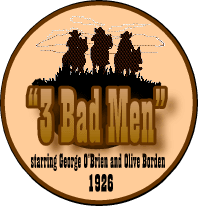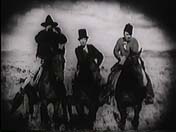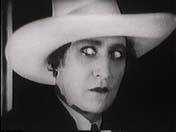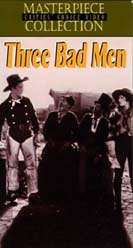

Fox Film, Corporation
Cast: George O'Brien (Dan O'Malley), Olive Borden (Lee Carleton), Tom Santschi ("Bull" Stanley), J. Farrell MacDonald (Mike Costigan), Frank Campeau ("Spade" Allen), Lou Tellegen (Layne Hunter), Priscilla Bonner (Millie), Phyllis Haver (Lily), Alec B. Francis (Reverend Benson), Otis Harlan (Zach Little), Georgie Harris (Joe Minsk), Jay Hunt (Nat Lucas). Directed by John Ford.
William S. Hart may have been the one who popularized the good-bad man persona, but he wasn't the only one who could do it and do it well.
John Ford takes the characterization a step further, actually two steps further, with three outlaws who have hearts of gold in his production of "3 Bad Men" (Fox Film Corp., 1926).
Dan O'Malley (played by George O'Brien) is a cowboy working with a wagon train moving west. He meets Lee Carleton (played by Olive Borden) and her father when he stops to help them replace a wagon wheel that has fallen off. The Carletons are on their way to the Dakota land rush with several race horses that they hope will serve them well in the race for land.
In this short scene, Dan and Lee make the usual flirtatious eye contact, and later Dan even holds her with head turned back and eyes closed - not to kiss her - but to wipe away a speck of mud she got on her face. Of course, she's willing, and Dan wants to, but, in typical cowpoke fashion, he never gets up the nerve.
Dan rides away to catch up with wagon train, which Lee's
father estimates is a full mile
ahead of them now, and the Carletons continue on their way alone.
However, they are spotted by three bad men - "Bull"
Stanley (played by Tom Santschi), Mike Costigan (played by J.
Farrell MacDonald), and "Spade" Allen (played by Frank
Campeau) - who decide to steal the race horses. Just as they are
about to swoop down on the Carletons, another gang of outlaws
rides in and overtakes the wagon. At first, the three faces show
complete bewilderment at the unsuspected turn of events, then
determination that no one is going to "horn in" on their
robbery. ". . . our business is getting overcrowded,"
Mike says, and the three charge the wagon with guns blazing.
mile
ahead of them now, and the Carletons continue on their way alone.
However, they are spotted by three bad men - "Bull"
Stanley (played by Tom Santschi), Mike Costigan (played by J.
Farrell MacDonald), and "Spade" Allen (played by Frank
Campeau) - who decide to steal the race horses. Just as they are
about to swoop down on the Carletons, another gang of outlaws
rides in and overtakes the wagon. At first, the three faces show
complete bewilderment at the unsuspected turn of events, then
determination that no one is going to "horn in" on their
robbery. ". . . our business is getting overcrowded,"
Mike says, and the three charge the wagon with guns blazing.
They succeed in running off the would-be robbers and find Lee kneeling over her father who has been killed in the melee. She gets up, turns to "Bull" and buries her face in his chest crying. The three "bad" men are softened by the girl and even agree to be hired, and paid later, by her when she can claim land, hopefully with gold upon it, in the land rush.
The four of them arrive in Custer where the land rush will begin. This rugged western town has sprung up overnight due to the thousands of land rushers swarming in for the free land which, hopefully, will have gold on it. The town's sheriff is Layne Hunter (played by Lou Tellegen), a crooked gang leader who uses his position to get what he wants. Unknown to Lee, it was Hunter's gang that killed her father in the aborted robbery attempt. Also, unknown to "Bull," Hunter is the very man he is looking for - the man who ran off with his sister, Millie (played by Priscilla Bonner). As fate would have it, Millie is right there in Custer still hoping Hunter will marry her.
While "Spade" and Mike are more concerned with getting drunk, "Bull" is agonizing over Lee. His brotherly instincts are apparently getting the better of him, and he decides they should find a husband for her. "Spade" and Mike provide a comic interlude when they "check out" a derby-wearing, cane-toting dandy as a possible husband, but it's "Bull" who runs across Dan O'Malley, who has just wandered into town for the land rush, and, ignorant of Dan's and Lee's earlier meeting, brings Dan back to "let nature take its course" with the two young people.
The pace of the story picks up considerably when some of Hunter's men kill the old prospector, Lucas (played by Jay Hunt), because he won't tell them where he found gold. However, before he dies, he tells the three bad men who shot him. They organize a revolt to rid the town of Hunter and his men, but, realizing what is happening, Hunter incites his men to burn down the local church where it just happens a large number of the town's womenfolk are having prayer with the minister. Hunter's drunken men set wagons on fire and run them into the church, then ambush the church so no one can escape the burning building. "Bull's" sister, Millie, jumps in front of the minister as he pleads with the ambushers for mercy, and she is shot. "Bull" and the other men arrive to rescue the women, and that is when he discovers his sister has been in the town all along.
"Bull" takes her back to the saloon and puts her in a bed. Before she dies, she tells him that Layne Hunter is the man with whom she ran away. He vows revenge against Hunter. After an unsuccessful attempt by "Bull" to find the villain, Hunter and his men cross over the land rush line to wait for Lee, Dan and the three bad men when the race begins the next day at noon.
"3 Bad Men" is truly one of the great epic westerns of the silent era. With this film, director John Ford provided a worthy follow-up to his classic "The Iron Horse" (Fox Film Corp., 1924). Although the film was praised by critics, it failed at the box office and did not recoup its $650,000 cost. However, Dan Ford says in his 1979 biography of his grandfather (Pappy: The Life of John Ford, Prentice-Hall) that "3 Bad Men" is ". . . quite possibly his (John Ford's) best silent film."
Once again Ford has provided a riveting story about everyday people against the backdrop of an historical event (this time, the Dakota land rush of 1877) without allowing "history" to overwhelm the characters. And, in true Ford fashion, the natural wonders of the wide open spaces give the story not only beauty but authenticity, as well. It was filmed in Jackson's Hole, Wyoming, where the crew experienced a real taste of western life as they lived in tents, ate from chuck wagons and bathed in the river. The land rush sequence was filmed in a dry lake bed in Victorville, CA., just outside Los Angeles.
Ford was good at making sure the grandness of his pictures didn't detract from the characters, and "3 Bad Men" is no exception. He chose George O'Brien (a Ford "discovery" who rose to stardom in "The Iron Horse") to portray happy-go-lucky Dan O'Malley. With his muscular physique, we expect O'Brien to play the part of the strong young buck who can take care of himself, and he gets the chance to do just that in scenes such as the one where he lifts a wagon by himself so the wheel can be put on it or when he defends himself in a fight in the saloon. However, O'Brien is also effective in his scenes with Olive Borden such as the one where he almost kisses her after wiping mud from her face or when he accidentally walks in on her taking a bath.
Borden is not only charming, but beautiful as well. It is no wonder she wins the hearts of the three bad men. Her scenes with O'Brien are a pure delight. After the initial shock of Dan walking in on her taking a bath, we see a deviish smile cross her face as she thinks about his embarassment. In another scene, Dan watches her walk behind one of the wagons, and all we see is an outstretched arm appear from around the wagon with her fingers waving, "Come along."
Tom Santschi was a veteran actor whose most famous role
was in the 1914 version of "The Spoilers" (Selig) with
William Farnum. He was at least 6'1" and weighed over 200
pounds. Santschi's appearance makes him a very believable "bad"
man, but he is equally believable when his brotherly instincts
come to the fore with Lee. Santschi gives a very effective and
sincere performance, and the viewer is really drawn to the character
first because of his good-heartedness at taking in Lee, then his
agony over losing his sister, and finally his determination to
see Dan and Lee have a happy future.
J. Farrell MacDonald as Mike Costigan and Frank Campeau as "Spade"
Allen look wicked enough when we first see them, but later they
provide the comic relief for the film. For example, in the scene
after the three of them run off the would-be robbers from Lee's
wagon, Lee buries her face in "Bull's" chest as he tries
to comfort her over the death of her father. Yet, in the background
we see Mike and "Spade" taking the opportunity of this
"tender" moment to steal her horses. Later in the film,
they try to find Lee a husband and come across a well-dressed
dandy whom they begin to "check out" like a couple of
dads on prom night. They attempt to guess the young man's age
at "32," then "28." The dandy, offended, says,
"I've just reached manhood," to which Mike replies,
"You'd better reach again."
Lou Tellegen in the role of Layne Hunter is an excellent
villain. Although outfitted in somewhat outlandish dress which
includes an extra wide brimmed white hat cocked to one side, waist
jacket and tie, it was Tellegen's face that was his greatest asset
in conveying villainy, and Ford took advantage of it in this film.
Twice he uses close-ups of Tellegen with dramatic effect. In one,
we see poor Millie knock on a small sliding wood door at eye level.
The door slides back and reveals Hunter looking perturbed at the
disturbance. Millie tells him a minister has come to town so they
can now get married. Tellegen's character doesn't respond to her.
All we can see through the small  door
is his face as he laughs and then forces the door shut while Millie
tries to hold it back. In another scene, Millie, lying in the
bed dying, tells "Bull" that it is Hunter who took her
away. "Bull" turns suddenly and recoils as if he has
seen something frightening. The screen is filled with an extreme
close-up of Hunter's stern face, steel-grey eyes glaring in hatred,
a shot which also makes the viewer recoil with a slight sense
of fright
door
is his face as he laughs and then forces the door shut while Millie
tries to hold it back. In another scene, Millie, lying in the
bed dying, tells "Bull" that it is Hunter who took her
away. "Bull" turns suddenly and recoils as if he has
seen something frightening. The screen is filled with an extreme
close-up of Hunter's stern face, steel-grey eyes glaring in hatred,
a shot which also makes the viewer recoil with a slight sense
of fright
There weren't many western "epics" made during
the silent era, so comparisons between the few that were made
are inevitable. Richard Koszarski in An Evening's Entertainment
(University of California Press, 1990) called "3 Bad Men"
a "powerful historic epic" and said it was "far
more satisfactory by any possible standard than "The Covered
Wagon" (Paramount, 1923). The land rush sequence in "3
Bad Men" is certainly as exciting and well-filmed as the
one in William S. Hart's "Tumbleweeds" (United Artists,
1925) and is aided by a much better developed and engrossing story
than Hart's film. Unfortunately, "3 Bad Men" hasn't
been available over the years as "The Covered Wagon"
and "Tumbleweeds"  have.
Nevertheless, it is certainly deserving of some of the notoriety
and praise that has been accorded these other films.
have.
Nevertheless, it is certainly deserving of some of the notoriety
and praise that has been accorded these other films.
copyright 1998 by Tim Lussier. All rights reserved.